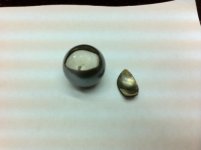cookierookie
Member
- Joined
- Jun 22, 2012
- Messages
- 119
Hi all,
A friend of mine who is a jeweller had a client come into her shop, and wanted to get some Tahitian pearls she bought from Greenhills pearl market set into earrings. The pearls she got looked like pearls, felt like pearls (gritty when rubbed against each other or against your teeth), and so they started drilling. The second they drilled the pearl, the nacre cracked! It was less than, but close to 1mm thick, but that was not the only shocking part. The nucleus appears to be a white man-made stone/plastic bead, which didn't hold up to the drilling, and also the reason why it cracked.
Have you guys ever come across this and does anyone know what it is? How did they even make the fake nacre feel like a real pearl?!
A friend of mine who is a jeweller had a client come into her shop, and wanted to get some Tahitian pearls she bought from Greenhills pearl market set into earrings. The pearls she got looked like pearls, felt like pearls (gritty when rubbed against each other or against your teeth), and so they started drilling. The second they drilled the pearl, the nacre cracked! It was less than, but close to 1mm thick, but that was not the only shocking part. The nucleus appears to be a white man-made stone/plastic bead, which didn't hold up to the drilling, and also the reason why it cracked.
Have you guys ever come across this and does anyone know what it is? How did they even make the fake nacre feel like a real pearl?!

